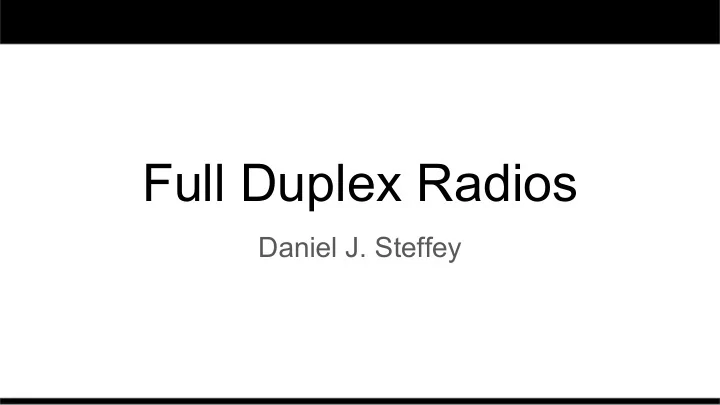

Full Duplex Radios Daniel J. Steffey
Source Full Duplex Radios* ACM SIGCOMM 2013 Dinesh Bharadia Emily McMilin Sachin Katti *All source information and graphics/charts 2
Problem “It is generally not possible for radios to receive and transmit on the same frequency band because of the interference that results.” - Andrea Goldsmith, Wireless Communications 2005 3
Motivation Double Throughput* Or Half Spectrum Requirements 4
How Capture / Estimate transmitted signal ❏ Subtract transmitted signal from received total signal ❏ Process residual received signal as received transmission ❏ 5
Prior Work “Achieving single channel, full duplex wireless communication” ❏ Choi, Jain, Srinivasan, Levis, and Katti ❏ “Experiment-driven characterization of full-duplex wireless systems” ❏ Duarte, Dick, and Sabharwal ❏ “Practical, real-time, full duplex wireless” ❏ Jain, Choi, Kim, Bharadia, Seth, Srinivasan, Lewis, Katti, and ❏ Sinha Requires at least two antennas (transmit and receive) ❏ Spaced >20cm apart ❏ Provides at most 85 dB of cancellation ❏ <5m distance required for improvement over half duplex ❏ 6
Current Research Completely cancel self-interference from received signal ❏ 110 dB of cancellation required ❏ Transmit at 100 mW = 20 dBm ❏ Noise floor is -90 dBm ❏ Single antenna for transmit and receive ❏ Ability to adapt to changing environment ❏ Analog cancellation ❏ Digital cancellation ❏ Frequency Independent ❏ Range of bandwidths (80 MHz WiFi, smaller LTE bands) ❏ No MIMO (future research) ❏ 7
Transmission What you want to send is not what you actually send ❏ 8
Cancellation Requirements 9
Design 10
Analog Cancellation At least 60 dB of cancellation ❏ Provides multiple copies of transmitted signal ❏ Delayed by various fixed amounts using parallel circuits of ❏ varying lengths; 16 delay lines is sufficient Programmatically attenuated by different variable amounts using ❏ tunable attenuators Voodoo Magic ❏ Using Nyquist Theorem and sinc interpolation can construct the ❏ self interference signal at instant d and remove from received signal 11
Analog Cancellation (cont.) 12
Analog Cancellation (cont.) What attenuation settings to use? ❏ Solve: ❏ Use a combination of precomputed values and a modified gradient ❏ descent algorithm to solve Algorithm takes ~900-1000µs ❏ Need to run every ~100ms ❏ Tuned and solved by looking at a WiFi preamble ❏ 13
Digital Cancellation - Linear Components 50 dB of cancellation for linear main signal component ❏ Complicated formula to “undo” distortions ❏ Feed in distorted digital signal ❏ Apply appropriate coefficients to the formula ❏ Output the undistorted signal ❏ What are the coefficients? ❏ Calculated on a per packet basis ❏ Determined by sampling the packet preamble ❏ Distorted Complicated Clean Preamble Formula Preamble Remainder Complicated Clean Packet of Packet Formula 14
Digital Cancellation - Non-Linear Components 20 dB of cancellation required (out of 80 dB total) ❏ Estimate transmitted signal as Taylor Series ❏ Analysis shows only odd-terms contribute non-zero energy in ❏ frequency band of interest (can ignore even terms) Ignore m=1 here as that is covered in the Linear Component ❏ Each successive term is lower power ❏ Empirically learn 224 terms are needed ❏ How do we get the factors of the terms? ❏ Same as Linear Component ❏ 15 Complicated formula to “undo” distortions ❏ Feed in distorted digital signal ❏ Apply appropriate coefficients to the formula ❏ Output the undistorted signal ❏ What are the coefficients? ❏ Calculated on a per packet basis ❏ Determined by sampling the packet preamble ❏
Project Proposal 16
Implementation 17
Evaluation Metrics ❏ Increase in Noise Floor ❏ SNR Loss ❏ Comparison ❏ Balun Design ❏ Rice Design ❏ 18 Complicated formula to “undo” distortions ❏ Feed in distorted digital signal ❏ Apply appropriate coefficients to the formula ❏ Output the undistorted signal ❏ What are the coefficients? ❏ Calculated on a per packet basis ❏ Determined by sampling the packet preamble ❏
Cancellation and Increase in Noise Floor 19
SNR Loss 20
Cancellation in Stages 21
SNR Loss vs Constellations and Bandwidths 22
Analog Cancellation - How Many Lines? 23
Effects of Digital Cancellation 24
Analog Cancellation Retuning 25
Throughput 26
What Do I Think? Very Interesting!!! ❏ MIMO ❏ When is it actually useful? ❏ Point-to-point systems with constant bi-directional transmission ❏ Cellular Systems ❏ General WiFi use ❏ 27
Questions / Comments 28
Recommend
More recommend